When I had first started taking PrEP (pre-exposure prophylaxis), I got severe headaches. They were so bad during the first month that I considered stopping altogether.
I couldn’t focus at work and my weekends were a write-off. However, by the fourth week they went away.
Side effects and adverse drug reactions are a part of modern medicine. According to Gilead’s website, common side effects of taking Truvada as PrEP can include abdominal pain, decrease in weight, as well as headaches, so I wasn’t concerned when I got mine.
The World Health Organization classifies “common” adverse drug reactions as those that occur within 1 to 10 percent of users.
I’ve met many people in Toronto and abroad since I first started PrEP a couple of years back who have been reluctant because of its potential side effects. Anecdotally, concerns about liver and kidney problems seem to be at the top of the list.
It’s true, Truvada as PrEP can cause some serious side effects, just like a lot of other medication. It can possibly lead to lactic acidosis, resulting in weakness, shortness of breath and abnormal heartbeats. It also can lead to serious liver or kidney problems (including kidney failure), as well as bone problems and changes in body fat. But in medicine, saying “it can” is much different than saying, “it will.”
Dr Howard Grossman is a physician who specializes in HIV medicine and is the director of AlphaBetterCare, an LGBT-friendly primary care provider serving New York City and New Jersey. I spoke to Grossman, via email, and he confirmed that such serious side effects are very rare, and added that even the common side effects aren’t that common at all: “I pretty much never see those effects,” he wrote. In July 2014, Grossman wrote an article for The Body Pro announcing he was starting PrEP.
These rare side effects are simply something to be conscious of when you start taking PrEP, and to be monitored for. If you’re at high risk of contracting HIV though, the possible side effects alone shouldn’t dissuade you from considering using Truvada as PrEP.
It’s also worth considering PrEP risk in relation to other, more commonly used drugs like acetaminophen, which can cause a host of side effects including bloody or black stool, fever, chills, hives, ulcers and unusual bleeding.
A recent report compared the use of PrEP for the prevention of HIV with Aspirin and concluded that PrEP was favorable for user safety. Although studies on long-term PrEP use are needed, research on short and medium-term PrEP use has concluded that it’s safe.
And this is not to say that we should ignore the side effects of PrEP.
In October 2016, we saw the second adverse event reported where a gay man in his early 20s acquired HIV, despite using PrEP. The case was presented by Grossman at this year’s HIV Research for Prevention conference in Chicago. His patient reported taking the top role with two casual partners without a condom, one of which allegedly had a virus with multiple resistance mutations.
His primary partner was HIV-positive and undetectable, and although he had condomless sex with him, the phylogenetic testing showed that he acquired the virus from outside of their relationship.
Statistically, PrEP protects against the transmission of HIV by over 99 percent.
Grossman had explained that there was no reason to think that Truvada would work in the face of a virus already resistant to the two drugs in it. However, he added that such cases are extremely rare.
There are approximately 100,000 people taking PrEP, and there have been only two incidents of failures — one in Toronto and one in New York — 2 in 100,000 is an extremely low failure rate; that’s 0.002 percent to be exact.
As renowned PrEP educator and marriage and family therapist, Damon Jacobs, thoughtfully pointed out in a piece for The Advocate titled, “Sex With PrEP, Like Life, Is Never Without Risk,” 133 pedestrians are killed in New York City each year by cars. Just walking out on the street is dangerous. There’s risk in everything we do.
Although HIV treatments have made advances, it’s still costly and current treatments have their own short-term and long-term toxicities. Plus, in 2014, there were 6,721 deaths in the United States attributed to HIV.
The good news is that the CDC estimated that expanding the use of PrEP to those who are at high risk could prevent 17,000 new HIV infections by 2020, so rather than focusing on what PrEP might do in very rare instances, maybe we should celebrate what it can do in most instances — prevent the spread of HIV.
PrEP School runs every other Monday on Daily Xtra. Columnist Mike Miksche explores and navigates the world of sex and PrEP.

 Why you can trust Xtra
Why you can trust Xtra


